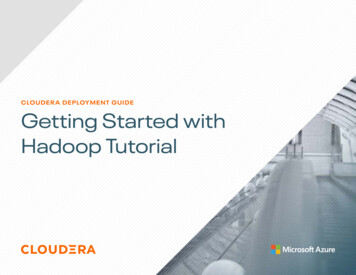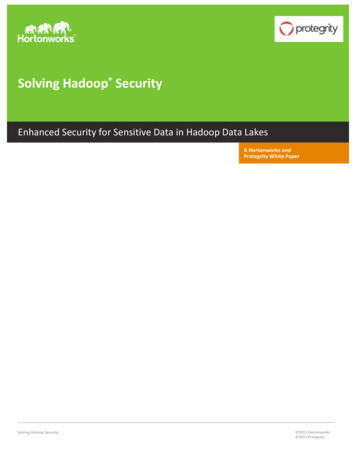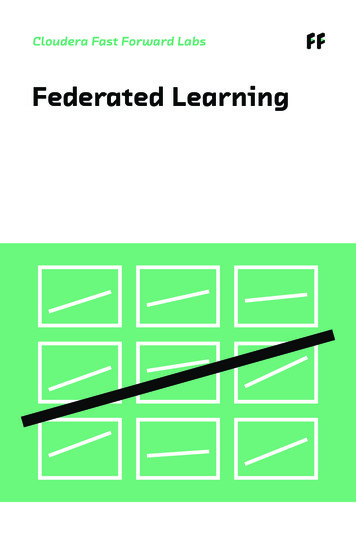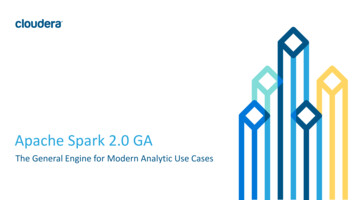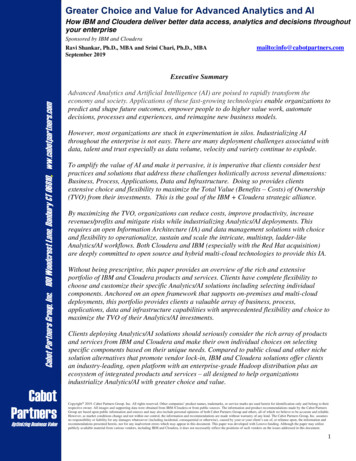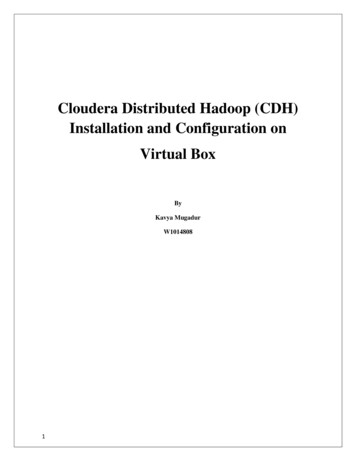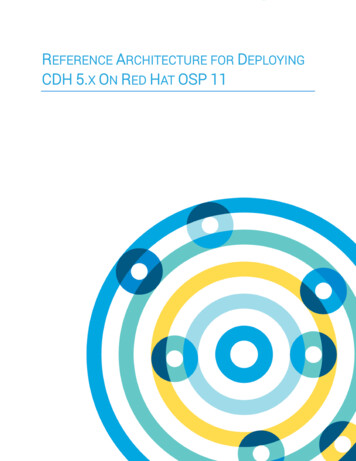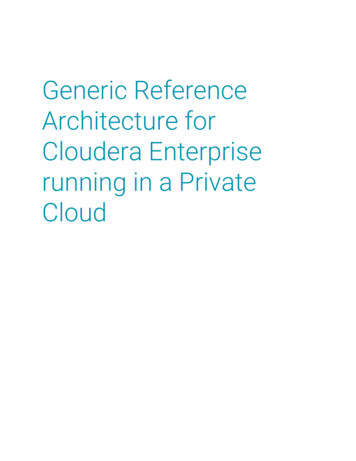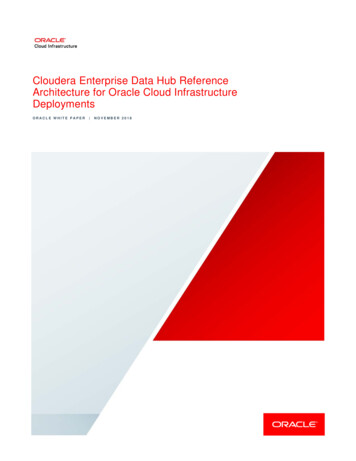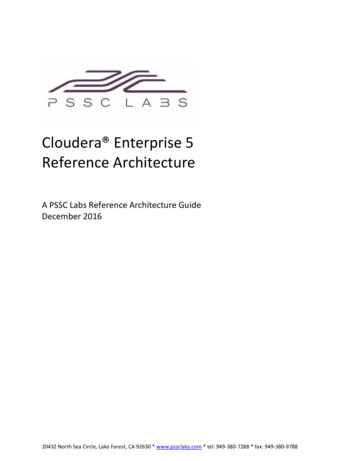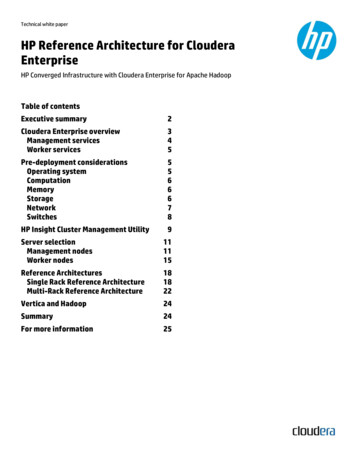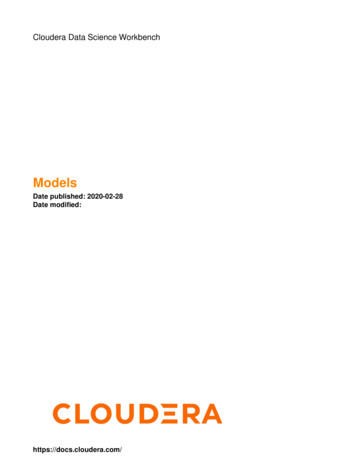
Transcription
Cloudera Data Science WorkbenchModelsDate published: 2020-02-28Date modified:https://docs.cloudera.com/
Legal Notice Cloudera Inc. 2021. All rights reserved.The documentation is and contains Cloudera proprietary information protected by copyright and other intellectual propertyrights. No license under copyright or any other intellectual property right is granted herein.Copyright information for Cloudera software may be found within the documentation accompanying each component in aparticular release.Cloudera software includes software from various open source or other third party projects, and may be released under theApache Software License 2.0 (“ASLv2”), the Affero General Public License version 3 (AGPLv3), or other license terms.Other software included may be released under the terms of alternative open source licenses. Please review the license andnotice files accompanying the software for additional licensing information.Please visit the Cloudera software product page for more information on Cloudera software. For more information onCloudera support services, please visit either the Support or Sales page. Feel free to contact us directly to discuss yourspecific needs.Cloudera reserves the right to change any products at any time, and without notice. Cloudera assumes no responsibility norliability arising from the use of products, except as expressly agreed to in writing by Cloudera.Cloudera, Cloudera Altus, HUE, Impala, Cloudera Impala, and other Cloudera marks are registered or unregisteredtrademarks in the United States and other countries. All other trademarks are the property of their respective owners.Disclaimer: EXCEPT AS EXPRESSLY PROVIDED IN A WRITTEN AGREEMENT WITH CLOUDERA,CLOUDERA DOES NOT MAKE NOR GIVE ANY REPRESENTATION, WARRANTY, NOR COVENANT OFANY KIND, WHETHER EXPRESS OR IMPLIED, IN CONNECTION WITH CLOUDERA TECHNOLOGY ORRELATED SUPPORT PROVIDED IN CONNECTION THEREWITH. CLOUDERA DOES NOT WARRANT THATCLOUDERA PRODUCTS NOR SOFTWARE WILL OPERATE UNINTERRUPTED NOR THAT IT WILL BEFREE FROM DEFECTS NOR ERRORS, THAT IT WILL PROTECT YOUR DATA FROM LOSS, CORRUPTIONNOR UNAVAILABILITY, NOR THAT IT WILL MEET ALL OF CUSTOMER’S BUSINESS REQUIREMENTS.WITHOUT LIMITING THE FOREGOING, AND TO THE MAXIMUM EXTENT PERMITTED BY APPLICABLELAW, CLOUDERA EXPRESSLY DISCLAIMS ANY AND ALL IMPLIED WARRANTIES, INCLUDING, BUT NOTLIMITED TO IMPLIED WARRANTIES OF MERCHANTABILITY, QUALITY, NON-INFRINGEMENT, TITLE, ANDFITNESS FOR A PARTICULAR PURPOSE AND ANY REPRESENTATION, WARRANTY, OR COVENANT BASEDON COURSE OF DEALING OR USAGE IN TRADE.
Cloudera Data Science Workbench Contents iiiContentsModels. 4Purpose. 4Introduction to Production Machine Learning.4Concepts and Terminology.7Creating and Deploying a Model (QuickStart).7Calling a Model. 10Updating Active Models.12Re-deploy an Existing Build. 13Deploy a New Build for a Model. 13Stop a Model. 14Restart a Model.14Securing Models using Model API Key.14Enabling Authentication. 15Generating a Model API Key. 15Managing Model API Keys. 16Enabling Model Metrics. 16Tracking Model Metrics. 16Usage Guidelines. 18Model Code.18Model Artifacts. 18Resouce Consumption and Scaling. 18Security Considerations. 18Deployment Considerations.18Known Issues and Limitations. 18Model Training and Deployment - Iris Dataset.19Create a Project.19Train the Model. 20Deploy the Model. 22Model Monitoring and Administration. 25Monitoring Individual Models.25Monitoring All Active Models.26Deleting a Model. 26Disabling the Models Feature. 27Debugging Issues with Models. 27Building. 27Pushing. 27Deploying. 27Deployed. 28
Cloudera Data Science WorkbenchModelsModelsStarting with version 1.4, Cloudera Data Science Workbench allows data scientists to build, deploy, and managemodels as REST APIs to serve predictions.Demo: Watch the following video for a quick demonstration of the steps described in this topic: Model Deploymentwith Cloudera Data Science WorkbenchPurposeThis topic describes the challenges and solutions that models address.ChallengeData scientists often develop models using a variety of Python/R open source packages. The challenge lies in actuallyexposing those models to stakeholders who can test the model. In most organizations, the model deployment processwill require assistance from a separate DevOps team who likely have their own policies about deploying new code.For example, a model that has been developed in Python by data scientists might be rebuilt in another language bythe devops team before it is actually deployed. This process can be slow and error-prone. It can take months to deploynew models, if at all. This also introduces compliance risks when you take into account the fact that the new redeveloped model might not be even be an accurate reproduction of the original model.Once a model has been deployed, you then need to ensure that the devops team has a way to rollback the model to aprevious version if needed. This means the data science team also needs a reliable way to retain history of the modelsthey build and ensure that they can rebuild a specific version if needed. At any time, data scientists (or any otherstakeholders) must have a way to accurately identify which version of a model is/was deployed.SolutionStarting with version 1.4, Cloudera Data Science Workbench allows data scientists to build and deploy their ownmodels as REST APIs. Data scientists can now select a Python or R function within a project file, and Cloudera DataScience Workbench will: Create a snapshot of model code, model parameters, and dependencies.Package a trained model into an immutable artifact and provide basic serving code.Add a REST endpoint that automatically accepts input parameters matching the function, and that returns a datastructure that matches the function’s return type.Save the model along with some metadata.Deploy a specified number of model API replicas, automatically load balanced.Introduction to Production Machine LearningMachine learning (ML) has become one of the most critical capabilities for modern businesses to grow and staycompetitive today. From automating internal processes to optimizing the design, creation, and marketing processesbehind virtually every product consumed, ML models have permeated almost every aspect of our work and personallives.Each CDSW installation enables teams of data scientists to develop, test, train and ultimately deploy machinelearning models for building predictive applications all on the data under management within the enterprise datacloud. Each ML workspace supports fully-containerized execution of Python, R, Scala, and Spark workloads throughflexible and extensible engines.Core capabilities Seamless portability across private cloud, public cloud, and hybrid cloud powered by Kubernetes4
Cloudera Data Science Workbench ModelsFully containerized workloads - including Python, and R - for scale-out data engineering and machine learningwith seamless distributed dependency managementHigh-performance deep learning with distributed GPU scheduling and trainingSecure data access across HDFS, cloud object stores, and external databasesCDSW usersCDSW users are: Data management and data science executives at large enterprises who want to empower teams to develop anddeploy machine learning at scale.Data scientist developers (use open source languages like Python, R, Scala) who want fast access to compute andcorporate data, the ability to work collaboratively and share, and an agile path to production model deployment.IT architects and administrators who need a scalable platform to enable data scientists in the face of shifting cloudstrategies while maintaining security, governance, and compliance. They can easily provision environments andenable resource scaling so they - and the teams they support - can spend less time on infrastructure and more timeon innovation.Challenges with model deployment and servingAfter models are trained and ready to deploy in a production environment, lack of consistency with modeldeployment and serving workflows can present challenges in terms of scaling your model deployments to meet theincreasing numbers of ML use-cases across your business.Many model serving and deployment workflows have repeatable, boilerplate aspects that you can automate usingmodern DevOps techniques like high-frequency deployment and microservices architectures. This approach canenable machine learning engineers to focus on the model instead of the surrounding code and infrastructure.Challenges with model monitoringMachine Learning (ML) models predict the world around them which is constantly changing. The unique andcomplex nature of model behavior and model lifecycle present challenges after the models are deployed.5
Cloudera Data Science WorkbenchModelsYou can monitor the performance of the model on two levels: technical performance (latency, throughput, and soon similar to an Application Performance Management), and mathematical performance (is the model predictingcorrectly, is the model biased, and so on).There are two types of metrics that are collected from the models:Time series metrics: Metrics measured in-line with model prediction. It can be useful to track the changes in thesevalues over time. It
Cloudera Data Science Workbench Models The ground truth can be stored in an external datastore, such as Cloudera Data Warehouse or in the metrics store. Use case 2: Tracking drift Instead of or in addition to computing ROC, the ML engineer may need to track various types of drift. Drift metrics
